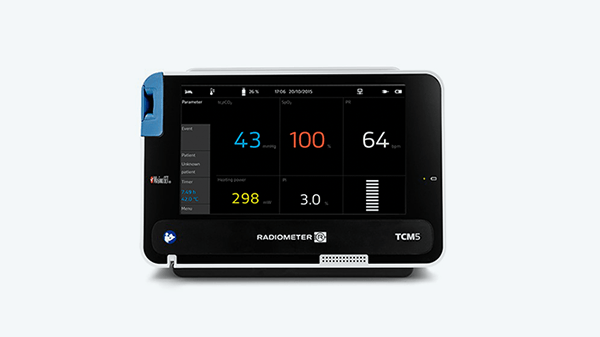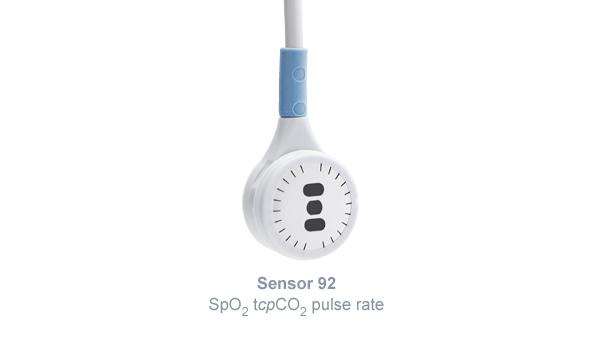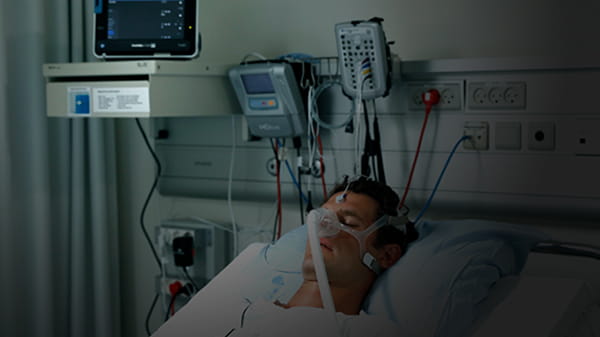
TCM5 BASIC transcutaneous monitor
Transcutaneous blood gas monitor for sleep diagnostics
-
 Simple to use
Simple to use
-
 Dark screen and noise-free
Dark screen and noise-free
-
 Highly accurate sensors
Highly accurate sensors
TCM5 BASIC transcutaneous monitor – ready when you are
When it comes to sleep diagnostics, preparation is key. You want all your devices and sensors set up and working properly before the patient arrives.
The TCM5 BASIC transcutaneous monitor helps make preparation easier. Built-in tutorials and a clear, simple user interface simplifies set up, usage and troubleshooting.
Automatic sensor calibration reduces preparation time, supporting your workflow in the sleep lab.


Parameters
Oxygen saturation, reported as a percentage of oxyhemoglobin (HbO2) on a total of oxy- and deoxy-hemoglobin. It is expressed by the formula: HbO2 / (HbO2+deoxyhemoglobin). It is measured non-invasively by pulse oximetry, an absorption-based technique. The relationship between SpO2 (measured by pulse oximetry) and pO2 is given by the oxygen dissociation curve.
tcpCO2 is measured through a sensor placed on the skin surface. A tcpCO2 sensor uses the Stow-Severinghaus principle. CO2 reacts with water and forms carbonic acid and dissociates into H+, which is interpreted through a pH glass element. After conversion, the sensor algorithm generates a tcpCO2 in mmHg (millimeters of mercury) or kPa (kilopascals)


A transcutaneous monitor delivering advanced connectivity and reporting features
The TCM5 BASIC transcutaneous monitor connects to major patient monitoring systems and polysomnographs enabling you to store, share and manage data and reports.
You can download patient data results to a PC or export them via USB with the integrated data memory that stores up to one year of continuous recorded data.




Accurate results with transcutaneous sensor
The surgical steel protected sensor offers reliable results even after prolonged use. Re-membraning needed every 28 days, freeing up valuable time for clinicians.
New for 2022: Improved sensor head design with better protection of the cable and greater pull strength.
Transcutaneous monitoring plays a very important part in making adjustments of invasive and non-invasive ventilator settings for nocturnal monitoring of ventilation status.
- Doctor Raffaele Piumelli, Medical Director Sleep Lab Department Meyer Children’s Hospital Florence, Italy
Related products and solutions
Cookies are used on this website
Use of cookiesPlease enter a valid email
We will be sending an e-mail invitation to you shortly to sign in using Microsoft Azure AD.
It seems that your e-mail is not registered with us
Please click "Get started" in the e-mail to complete the registration process
Radiometer is using Microsoft AZURE Active Directory to authenticate users
Radiometer uses Azure AD to provide our customers and partners secure access to documents, resources, and other services on our customer portal.
If your organization is already using Azure AD you can use the same credentials to access Radiometer's customer portal.
Key benefits
- Allow the use of existing Active Directory credentials
- Single-sign on experience
- Use same credentials to access future services
Request access
You will receive an invitation to access our services via e-mail when your request has been approved.
When you accept the invitation, and your organization is already using AZURE AD, you can use the same credentials to access Radiometer's customer portal. Otherwise, a one-time password will be sent via e-mail to sign in.



